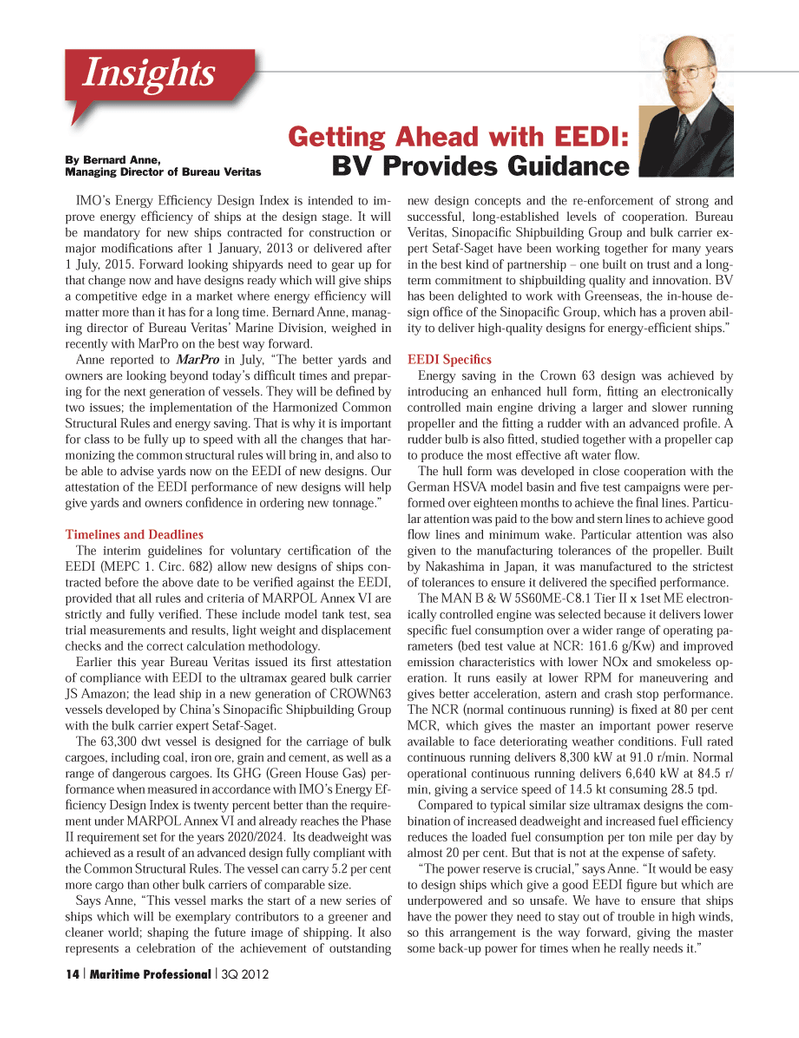
Page 14: of Maritime Logistics Professional Magazine (Q3 2012)
Classification Societies, Quality & Design
Read this page in Pdf, Flash or Html5 edition of Q3 2012 Maritime Logistics Professional Magazine
IMO?s Energy Ef ciency Design Index is intended to im- prove energy ef ciency of ships at the design stage. It will be mandatory for new ships contracted for construction or major modi cations after 1 January, 2013 or delivered after 1 July, 2015. Forward looking shipyards need to gear up for that change now and have designs ready which will give ships a competitive edge in a market where energy ef ciency will matter more than it has for a long time. Bernard Anne, manag- ing director of Bureau Veritas? Marine Division, weighed in recently with MarPro on the best way forward. Anne reported to MarPro in July, ?The better yards and owners are looking beyond today?s dif cult times and prepar- ing for the next generation of vessels. They will be de ned by two issues; the implementation of the Harmonized Common Structural Rules and energy saving. That is why it is important for class to be fully up to speed with all the changes that har- monizing the common structural rules will bring in, and also to be able to advise yards now on the EEDI of new designs. Our attestation of the EEDI performance of new designs will help give yards and owners con dence in ordering new tonnage.? Timelines and Deadlines The interim guidelines for voluntary certi cation of the EEDI (MEPC 1. Circ. 682) allow new designs of ships con- tracted before the above date to be veri ed against the EEDI, provided that all rules and criteria of MARPOL Annex VI are strictly and fully veri ed. These include model tank test, sea trial measurements and results, light weight and displacement checks and the correct calculation methodology. Earlier this year Bureau Veritas issued its rst attestation of compliance with EEDI to the ultramax geared bulk carrier JS Amazon; the lead ship in a new generation of CROWN63 vessels developed by China?s Sinopaci c Shipbuilding Group with the bulk carrier expert Setaf-Saget. The 63,300 dwt vessel is designed for the carriage of bulk cargoes, including coal, iron ore, grain and cement, as well as a range of dangerous cargoes. Its GHG (Green House Gas) per- formance when measured in accordance with IMO?s Energy Ef- ciency Design Index is twenty percent better than the require- ment under MARPOL Annex VI and already reaches the Phase II requirement set for the years 2020/2024. Its deadweight was achieved as a result of an advanced design fully compliant with the Common Structural Rules. The vessel can carry 5.2 per cent more cargo than other bulk carriers of comparable size. Says Anne, ?This vessel marks the start of a new series of ships which will be exemplary contributors to a greener and cleaner world; shaping the future image of shipping. It also represents a celebration of the achievement of outstanding new design concepts and the re-enforcement of strong and successful, long-established levels of cooperation. Bureau Veritas, Sinopaci c Shipbuilding Group and bulk carrier ex- pert Setaf-Saget have been working together for many years in the best kind of partnership ? one built on trust and a long- term commitment to shipbuilding quality and innovation. BV has been delighted to work with Greenseas, the in-house de- sign of ce of the Sinopaci c Group, which has a proven abil- ity to deliver high-quality designs for energy-ef cient ships.? EEDI SpeciÞ csEnergy saving in the Crown 63 design was achieved by introducing an enhanced hull form, tting an electronically controlled main engine driving a larger and slower running propeller and the tting a rudder with an advanced pro le. A rudder bulb is also tted, studied together with a propeller cap to produce the most effective aft water ow. The hull form was developed in close cooperation with the German HSVA model basin and ve test campaigns were per- formed over eighteen months to achieve the nal lines. Particu- lar attention was paid to the bow and stern lines to achieve good ow lines and minimum wake. Particular attention was also given to the manufacturing tolerances of the propeller. Built by Nakashima in Japan, it was manufactured to the strictest of tolerances to ensure it delivered the speci ed performance. The MAN B & W 5S60ME-C8.1 Tier II x 1set ME electron- ically controlled engine was selected because it delivers lower speci c fuel consumption over a wider range of operating pa- rameters (bed test value at NCR: 161.6 g/Kw) and improved emission characteristics with lower NOx and smokeless op- eration. It runs easily at lower RPM for maneuvering and gives better acceleration, astern and crash stop performance. The NCR (normal continuous running) is xed at 80 per cent MCR, which gives the master an important power reserve available to face deteriorating weather conditions. Full rated continuous running delivers 8,300 kW at 91.0 r/min. Normal operational continuous running delivers 6,640 kW at 84.5 r/ min, giving a service speed of 14.5 kt consuming 28.5 tpd. Compared to typical similar size ultramax designs the com-bination of increased deadweight and increased fuel ef ciency reduces the loaded fuel consumption per ton mile per day by almost 20 per cent. But that is not at the expense of safety. ?The power reserve is crucial,? says Anne. ?It would be easy to design ships which give a good EEDI gure but which are underpowered and so unsafe. We have to ensure that ships have the power they need to stay out of trouble in high winds, so this arrangement is the way forward, giving the master some back-up power for times when he really needs it.? Getting Ahead with EEDI: BV Provides Guidance By Bernard Anne, Managing Director of Bureau Veritas Insights14 I Maritime Professional I 3Q 2012MP #3 1-17.indd 14MP #3 1-17.indd 148/14/2012 5:04:30 PM8/14/2012 5:04:30 PM

 13
13

 15
15
